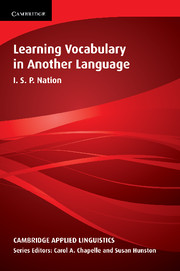Book contents
- Frontmatter
- Contents
- Series editors' preface
- Acknowledgements
- Introduction
- 1 The goals of vocabulary learning
- 2 Knowing a word
- 3 Teaching and explaining vocabulary
- 4 Vocabulary and listening and speaking
- 5 Vocabulary and reading and writing
- 6 Specialised uses of vocabulary
- 7 Vocabulary learning strategies and guessing from context
- 8 Word study strategies
- 9 Chunking and collocation
- 10 Testing vocabulary knowledge and use
- 11 Designing the vocabulary component of a language course Goals
- Appendixes
- References
- Subject index
- Author index
5 - Vocabulary and reading and writing
Published online by Cambridge University Press: 05 October 2012
- Frontmatter
- Contents
- Series editors' preface
- Acknowledgements
- Introduction
- 1 The goals of vocabulary learning
- 2 Knowing a word
- 3 Teaching and explaining vocabulary
- 4 Vocabulary and listening and speaking
- 5 Vocabulary and reading and writing
- 6 Specialised uses of vocabulary
- 7 Vocabulary learning strategies and guessing from context
- 8 Word study strategies
- 9 Chunking and collocation
- 10 Testing vocabulary knowledge and use
- 11 Designing the vocabulary component of a language course Goals
- Appendixes
- References
- Subject index
- Author index
Summary
Just as the oral skills of listening and speaking can contribute to vocabulary growth, so can the written skills of reading and writing. Indeed, control of the reading skill can be a major factor in vocabulary development for both native and non-native speakers.
Research on L1 reading shows that vocabulary knowledge and reading comprehension are very closely related to each other (Stahl, 1990). This relationship is not one directional. Vocabulary knowledge can help reading, and reading can contribute to vocabulary growth (Chall, 1987).
Vocabulary size and successful reading
There has been continuing interest in whether there is a language knowledge threshold which marks the boundary between not having and having enough language knowledge for successful language use. There are at least two ways of defining what a threshold is. One way is to see a threshold as an all-or-nothing phenomenon. If a learner has not crossed the threshold, then adequate comprehension is not possible. If the learner has crossed the threshold, then, other things being equal, comprehension is possible for all learners. This is the strong view of a threshold and the one that corresponds to its traditional meaning.
Another way is to see a threshold as a probabilistic boundary. That is, if a learner has not crossed the threshold, the chances of comprehending adequately are low. If the learner has crossed the threshold, the chances are on the side of the learner gaining adequate comprehension.
- Type
- Chapter
- Information
- Learning Vocabulary in Another Language , pp. 144 - 186Publisher: Cambridge University PressPrint publication year: 2001
- 2
- Cited by

